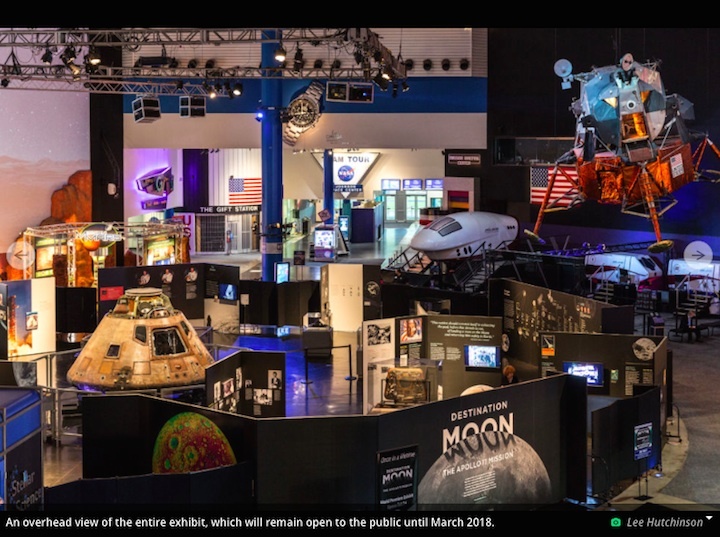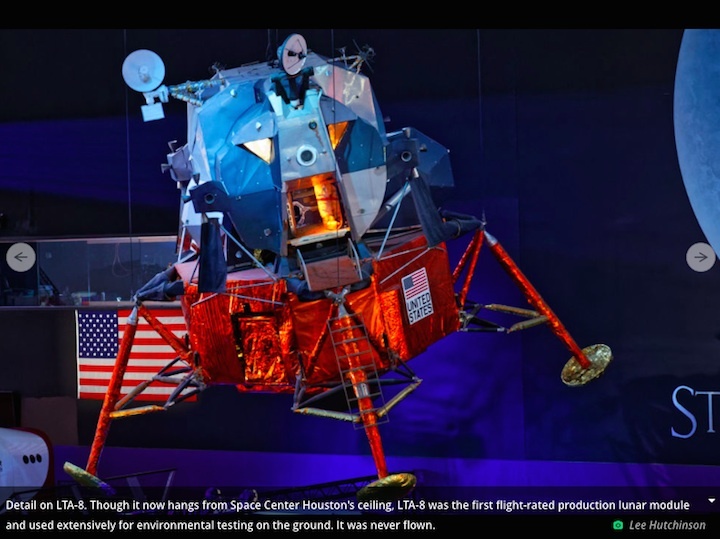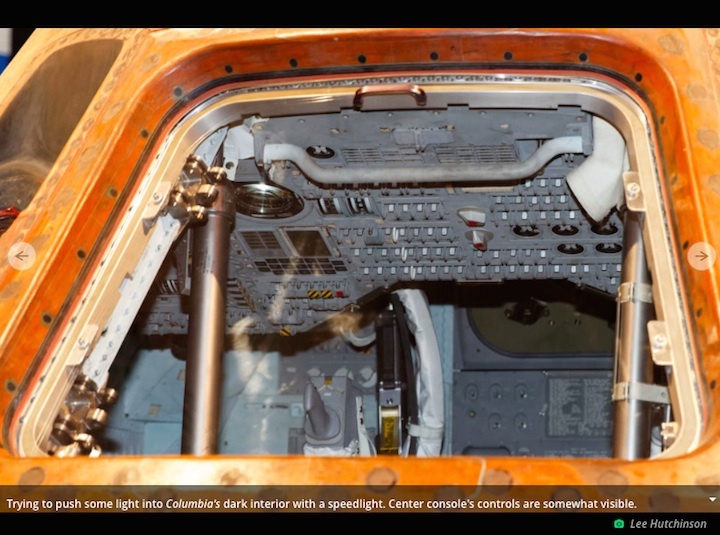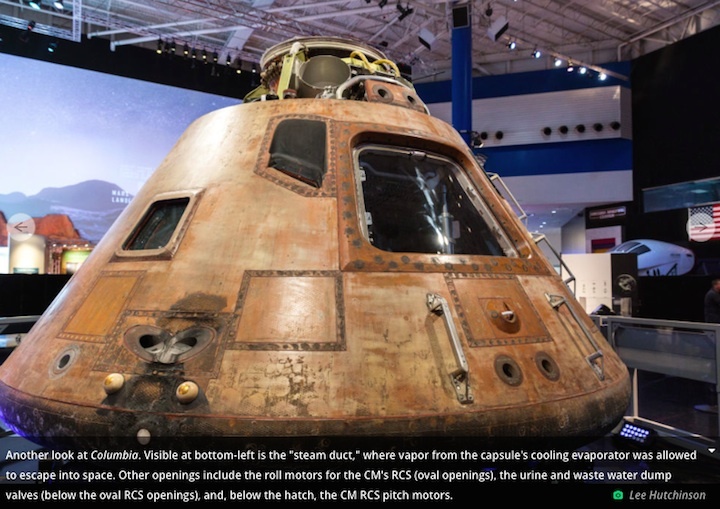13.10.2017

50 years later, the Apollo 11 command module still dazzles
A four-city tour comes on the 50th anniversary of NASA’s Moon landings.
HOUSTON—After carrying Neil Armstrong, Buzz Aldrin, and Michael Collins to the Moon in 1969, the Apollo 11 command module splashed into the Pacific Ocean. The spacecraft then returned to Houston with the astronauts before embarking on a tour to all 50 states in 1970 and 1971. An estimated three million people visited the spacecraft along the way as it stopped in one city per state, usually the capital.
Following that tour, the historic capsule was installed at Smithsonian's National Air and Space Museum, and it remained there as one of the institution's most prized artifacts. Now, finally, the 3.9-meter wide spacecraft is going on tour again. It won't be visiting all 50 states but instead a select few cities—Houston, St. Louis, Pittsburgh, and, lastly, for the 50th anniversary of the Apollo 11 landing in 2019, Seattle. The latter city gets the honor because Amazon founder Jeff Bezos is among those underwriting the tour.
The capsule makes its first public appearance on Saturday, October 14 at Space Center Houston. During a media preview, we got a look at the exhibit, which will let visitors get a little more than an arm's length away from the capsule. This close, we could see how hard the return trip through the atmosphere was on the spacecraft's heat shield, as well as the wear and tear from the reaction control system thrusters. The capsule is indeed an iconic sight to behold, and it looks all the better for a thorough cleaning and conservation effort before the tour began.
During its engagement until March 2018 at the visitor's center near Johnson Space Center, space buffs can see both the Apollo 11 capsule and, in a nearby exhibit, the Apollo 17 capsule. Both vehicles have launched to the Moon and back and appear similar. "This is an opportunity to see the historic bookends of the Apollo program," said William Harris, president and chief executive of Space Center Houston.
Other intriguing objects in the "Destination Moon" exhibit include the visor and gloves Aldrin wore on the Moon's surface, a shiny lunar sample return container, Michael Collins' Omega Speedmaster watch, and more. A 3D tour of the spacecraft also highlights graffiti left inside the "Columbia" module by the astronauts. There is also a Moon rock, of course.
This four-city tour, coming on the 50th anniversary of NASA's Moon landings, is a welcome addition to efforts to highlight the amazing things humans can do in space with clear goals and the funding to accomplish them. In the coming months, Ars will launch its own ambitious series to commemorate the Apollo program, from its successes and travails, to a legacy that reverberates even today in the spaceflight community.



Quelle: ars technica
+++
Apollo 11 spacecraft traveling exhibit lands at Space Center Houston
|
October 12, 2017
— A moon ship has landed in "Space City." |
 Photos credit: collectSPACE |
|
"Destination Moon: The Apollo 11 Mission," the Smithsonian's new traveling exhibition, is ready to launch on Saturday (Oct. 14) at Space Center Houston, the official visitor center for NASA's Johnson Space Center in Texas and a Smithsonian Affiliate. (collectSPACE) |
|
The title board for "Destination Moon: The Apollo 11 Mission" introduces the overall theme of the exhibit: "Why did the United States send astronauts to the moon? And how did we do it?" (collectSPACE) |
|
The 5,000-square-foot (465-square-meter) exhibition includes more than 20 artifacts from Apollo 11, the first mission to land humans on the moon in July 1969. Many of the artifacts have not been seen outside the National Air and Space Museum in Washington, D.C. (collectSPACE) |
|
The Apollo 11 command module is exhibited in "Destination Moon" with its crew access hatch. (collectSPACE) |
|
Columbia's hatch served as the entry and exit point to the spacecraft on the launch pad and after landing. It could also have been used for an emergency transfer from the lunar module Eagle if docking failed. (collectSPACE) |
|
Columbia is the only part of the Apollo 11 spacecraft to return intact to Earth. It carried the crew, equipment and lunar samples through a fiery re-entry into the Earth's atmosphere. (collectSPACE) |
|
Columbia's display as part of "Destination Moon" marks the first time the command module has been exhibited outside of the Smithsonian in 46 years. The spacecraft is displayed without a cover, but within a perimeter just out of arm reach of the public. (collectSPACE) |
|
A lunar module, LTA-8, used for astronaut training at Johnson Space Center has been on exhibit at Space Center Houston for 25 years. The elevated display offers a backdrop for Columbia in "Destination Moon." (collectSPACE) |
|
Before leaving on tour, Columbia underwent a six-month conservation, including being meticulously cleaned. The work exposed details on the spacecraf's heat shield, such as pre-flight repairs, that were not as clearly visible as before. (collectSPACE) |
|
The Apollo 11 medical kit included motion sickness and pain suppression injectors, first aid ointment, eye drops, nasal sprays, adhesive and compress bandages and an oral thermometer. Pills included antibiotics, anti-nausea, stimulants and painkillers. (collectSPACE) |
|
Part of the first-stage engine from Apollo 11's Saturn V rocket, the injector plate, recovered from the bottom of the Atlantic Ocean in 2013, sprayed liquid oxygen and kerosene fuel into the combustion chamber and helped regulate the flow of the hot gases. (collectSPACE) |
|
The F-1 engine injector plate is making its public display debut as part of "Destination Moon: The Apollo 11 Mission." (collectSPACE) |
|
One of two Apollo 11 rucksacks that was filled with equipment to help the crew survive for up to 48 hours in the event of an emergency landing somewhere on Earth. The contents include three water containers, a radio beacon and spare battery, three pairs of sunglasses, six packages of desalting chemicals, a seawater desalter kit, two survival lights, a machete and two bottles of sunscreen. (collectSPACE) |
|
This model shows the various production stages including substrate material, coatings, structure and curing of the Columbia's heat shield that protected the command module from the extreme heat of atmospheric re-entry. (collectSPACE) |
|
Lunar sample 15058,188 (024) was collected by astronaut Jim Irwin during the Apollo 15 mission in July 1971. (collectSPACE) |
|
The lunar sample return container, or "rock box," was one of two used by the Apollo 11 astronauts to bring back the first samples of the moon to Earth — 47.7 pounds (21.8 kilograms) of material from the Sea of Tranquility. (collectSPACE) |
|
On loan from Apollo 11 lunar module pilot Buzz Aldrin, the Duro felt-tip pen that Aldrin used to actuate a circuit breaker aboard the lunar module Eagle after the circuit breaker's nib was accidentally broken off (the nib also on exhibit). Visible in the background, Michael Collins' Omega Speedmaster chronograph worn during the Apollo 11 mission and a star chart flown on the mission that shows the positions of the sun, moon and stars at the time Apollo 11 was scheduled to leave Earth orbit and head for the moon. (collectSPACE) |
|
Buzz Aldrin wore this outer helmet (at left) while on the surface of the moon. It fit over his clear pressure-bubble helmet. (collectSPACE) |
|
Buzz Aldrin's extravehicular gloves have an outer, cut-resistant shell of Chromel-R fabric across the hands to prevent fatal air leaks caused by handling sharp objects and gauntlets to protect against solar heating. The silicone rubber fingertips offered more sensitivity for touching. The display includes a magnifying glass for viewing the checklist on the gauntlet. (collectSPACE) |
|
"Destination Moon: The Apollo 11 Mission" is on display at Space Center Houston from Oct. 14, 2017 through March 18, 2018. (collectSPACE) |
Quelle: collectSPACE




















